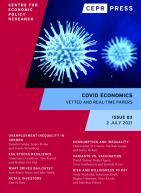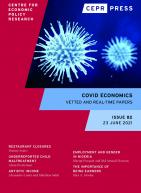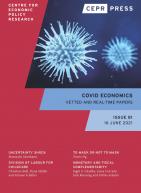
The economic shutdown associated with the COVID-19 pandemic witnessed a surge in drawdowns on pre-existing credit lines. This paper examines how this liquidity was used by firms. Drawdowns were associated with an immediate accumulation of liquid assets followed by a depletion of this liquidity as the U.S. economy stabilized after the spring of 2020. Drawdowns were generally not associated with greater levels of physical investment or employment either immediately after the drawdowns or several months later. Rather, the depletion of liquidity is simultaneous with an increase in the equity to assets ratio, consistent with repayments of the drawdowns. These facts are consistent with the idea that firms drew down their credit lines due to a precautionary motive to mitigate future liquidity risk until the economy started to stabilize. However, we find evidence that firms in industries that were less affected by the shutdown, such as professional services that can be performed remotely, were relatively more likely to use drawdowns to maintain investment rather than accumulate liquidity. On the intensive margin, this is especially true for firms in such industries that drew a relatively small amount of funds.
Citation
Kakhbod, A and J Bosshardt (2021), ‘Why did Firms Draw Down their Credit Lines during the COVID-19 Shutdown?‘, COVID Economics 78, CEPR Press, Paris & London. https://cepr.org/publications/covid-economics-issue-78#392514_392954_390768
The outbreak of the Covid-19 pandemic massively increased uncertainty about firms’ cash flows and access to financial markets. We examine its effect on firms’ strategies for preserving cash by suspending dividends and share repurchase programs and raising new funds through bond and equity issues. Our estimates suggest that between March and December 2020 US firms saved a combined $86bn by suspending or reducing dividend payments and another $140bn from suspending buybacks. We identify a short list of firm and stock characteristics that explain most of the cross-sectional variation in firms’ payout and financing decisions. We show that the expansive monetary policies pursued by the Federal Reserve in the early phase of the pandemic crucially affected the timing and sequencing of firms’ decisions. Announcement effects on stock returns were highly unusual during the pandemic as dividend and buyback suspensions were associated with a more rapid recovery in firms’ stock prices, consistent with investors interpreting them as prudent actions that helped reduce risks.
Citation
Sabbatucci, R, A Timmermann and D Pettenuzzo (2021), ‘Outlasting the pandemic: Corporate payout and financing decisions during Covid-19‘, COVID Economics 78, CEPR Press, Paris & London. https://cepr.org/publications/covid-economics-issue-78#392514_392954_408811
This paper assesses the mitigating role of remittances during the adverse COVID-19 employment shock on Nigeria’s food insecurity. Based on pre-COVID-19 and post- COVID-19 surveys, we use a difference-in-difference approach while controlling for time and household fixed effects. Results indicate that remittances are mitigating the negative consequences of COVID-19 employment shocks, especially in the short run. We find that 100% of the deterioration in food insecurity, owing to the shock, is offset by the remittances received. While the adverse effects of the shock persist over time, the mitigation effects of remittances appear to be effective only at the early stages of the pandemic. Furthermore, the mitigation effect of remittances is heterogeneous regarding the origin of remittances, residence area, and poverty status. The mitigation effect of remittances is higher for remittances from abroad than for domestic ones. We also find a higher mitigating effect of remittances in rural areas and for non-poor households. Finally, our results shed light on the capital channel as a crucial mechanism explaining the mitigation effect of remittances. Notably, our findings suggest that formal financial inclusion, capital ownership like livestock or rental earnings, amplifies the attenuating effect of remittances.
Citation
Ayivodji, F, J Kouton and A Akim (2021), ‘Do Remittances Mitigate COVID-19 Employment Shock on Food Insecurity? Evidence from Nigeria‘, COVID Economics 78, CEPR Press, Paris & London. https://cepr.org/publications/covid-economics-issue-78#392514_392954_390769
This paper estimates the differential impact of the covid-19 pandemic on the housing market of different neigbourhoods within the city boundaries of a tourist-intensive capital with a high density of short-term rental properties. This is the first paper to analyse the consequences of a shifting of dwellings from the short-term into the long-term rental market. We use a panel that spans the 24 civil parishes of Lisbon between the third quarter of 2018 and the third quarter of 2020. Our identification combines the sudden and sharp decrease in tourism caused by the covid-19 pandemic with a parish-level treatment relying on the pre-pandemic intensity of short-term rentals. We use difference-in-differences specifications, and an instrumental variable based on the density of museums. We show that in the long-term rental market, prices decrease 4.1%, while quantities increase 20% in the treated civil parishes vis-à-vis comparison ones. We also find evidence of an incremental negative impact on sale prices of 4.8% in treated civil parishes, with no effect on quantities. The results are robust to the inclusion of the second largest city of the country.
Citation
Pereira Dos Santos, J, D Gonçalves, S Peralta and M Batalha (2021), ‘The Virus that Devastated Tourism: the Impact of Covid-19 on the Housing Market‘, COVID Economics 78, CEPR Press, Paris & London. https://cepr.org/publications/covid-economics-issue-78#392514_392954_390767
In an original contribution to the COVID-19 and trade literature, we examine the trade policy passthrough to trade flows of restrictive and liberalizing measures imposed on exports and imports of food and medical products (Evenett et al. 2021) during the first nine months of 2020 for a sample of 142 countries. We find that where the imposition of trade policy measures is more consistent with theoretical/conceptual predictions, such measures are also found to be associated with trade flow changes that are less idiosyncratic. This is found to be true in general for trade policy measures imposed on exports and imports of medical products; for food products, stylized facts suggest that the trade policy activism may have been more idiosyncratic. In some cases, however, accounting for sample heterogeneities renders the results less idiosyncratic. On the whole, our results suggest that richer, more globally integrated economies with high levels of government effectiveness may have exhibited higher trade policy effectiveness during the first nine months of the pandemic.
Citation
Shingal, A and P Agarwal (2021), ‘COVID-era Trade Policy Passthrough to Trade Flows: Idiosyncratic or not?‘, COVID Economics 78, CEPR Press, Paris & London. https://cepr.org/publications/covid-economics-issue-78#392514_392954_390766


Covid Economics - Issue 82
- Restaurant Closures during the Pandemic: A Descriptive Analysis
- Underreporting Child Maltreatment during the Pandemic: Evidence from Colorado
- Covid-19 impact on Artistic Income
- COVID-19, Employment, and Gender: Evidence from Nigeria
- The Importance of Being Earners: Modelling the Implications of Changes to Welfare Contributions on Macroeconomic Recovery
